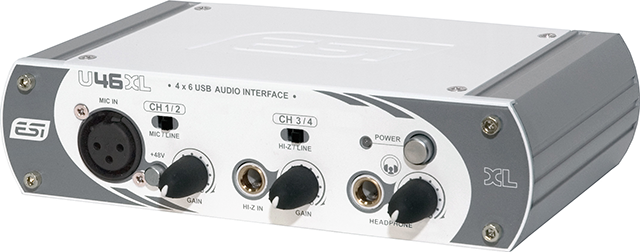
Lets review professional external studio audio interface ESI U46 XL, which is designed for majority of sound recording tasks. It is created on base of preceding model ESI U46DJ. Card’s frontal panel has : balanced XLR microphone input ( this allows to neutralize all noises, which are added to signal during its movement in the cable ) with ability to switch +48 V phantom pwer, switch for choosing of linear or microphone work mode of the input, phantom power button and amplification level control knob; instrumental TRS 6.3 mm ( 1/4″ ) jack Hi-Z input, its Hi-Z or linear work modes switch and amplification level control knob; TRS 6.3 mm ( 1/4″ ) jack output for monitor headphones, their volume level control and power button. Back panel of sound card has : USB port and power adapter input; analogue TRS 6.3 mm ( 1/4″ ) jack mix inputs for left and right channels; 6 analogue RCA outputs ( which can work as 6 independent analogue outputs or as outputs for 5.1 channel audio system ); and 4 analogue RCA inputs. Sound card works on 48 kHz sampling rate with 24 bits precision and 100 dB range of digital-to-analogue and analogue-to-digital conversions. Body of card is produced from aluminum to increase its durability and to reduce electro-magnetic interference on its electronics.
For it drivers are released for Windows XP, Vista, 7, 8, 8.1 and 10 ( with MME, WDM and ASIO 2.0 interfaces and DirectWIRE support ) and Mac OS X 10.3 and newer ( with support of Core Audio ) operating systems, with which it can tightly integrate with modern DAWs : FL Studio, Cackewalk Sonar, REAPER, Avid Pro Tools, Ableton Live, Steinberg Cubase and others. Card is bundled with DAW Steinberg Cubase LE for PC and Mac systems. Package contains : ESI U46 XL sound card itself, USB cable, optical disks with drivers and software and user’s guide. All in all, this a good professional studio sound card, which supports majority of functions, except of MIDI and digital connectors; its other minuses are support of only 48 kHz sampling rate ( this is due to big channels amount and USB 2.0 bus speed capabilities limits reaching; but higher sampling rates are not always needed, for example, if sound will not be processed too much after recording ) and lack of volume level and clip indicators on its body. So, this interface should be bought only if it will be used exactly for functions, for which it is designed; if there is need to simply buy studio level or fully functional audio interface, then it is better to buy device, which has full spectrum of audio connectors and functions, for approximately the same price.



